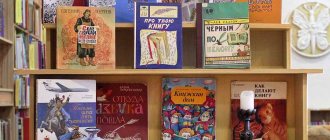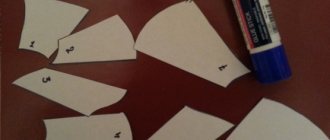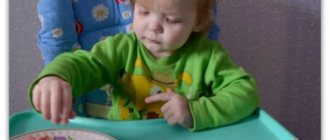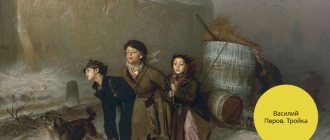Summary of the conversation for children of the senior preparatory group of kindergarten: Cartoons
Conversation for children 5-7 years old: Cartoons are the joy of childhood.
Author: Tatyana Nikolaevna Dvoretskaya GBOU School No. 1499 DO No. 7 Educator Description: The conversation is intended for preschool teachers, parents and children.
Purpose of the work: The conversation will allow you to consolidate children’s knowledge about the characters of their favorite cartoons in a fun, playful way. Goal: to develop interest in watching Soviet cartoons among preschool children. Objectives: 1. to cultivate interest in cartoons among preschoolers; 2. encourage children to actively discuss the plot and retell it; 3. to form emotional responsiveness to an animated film; 4. consolidate children’s knowledge about cartoons and their characters. Preliminary work: - watching cartoons;
— exhibition of children's drawings: My favorite hero. Poem: Cartoons are the joy of childhood!
Author: Dvoretskaya Tatyana Nikolaevna Cartoons are the joy of childhood! Pleasant neighborhood! They open up a different world, unreal and funny! Without hiding, let's be honest, the characters on the screen are our true friends! And you can’t live without them! The secret of popularity is that they bring kindness and light!
All children love to watch cartoons. Do you agree? Name your favorite cartoons and their characters (Children's answers) Many years ago, there were no computers or televisions. And the main activities of the children were games, drawing, modeling, listening to fairy tales. The first kind of cartoons appeared a long time ago in China and India. It was a shadow theater - an ancient form of folk art. The dolls were carved from donkey skins. Such dolls were set in motion using threads and sticks. A large paper screen was stretched over a bamboo frame and raised above the ground to a small height. The audience sat in front of the screen and watched the performance.
The doll in the form of a light shadow came to life and moved. Such actions were accompanied by music. The people who were on the other side of the screen and pulled the strings or sticks, thereby forcing the doll to move, were called puppeteers.
Cartoon, animation, is a type of cinematic art, the works of which are created by filming successive phases of the movement of objects. Cartoons can be created in different techniques. But the most popular ones are hand-drawn or doll-like. Creating a hand-drawn cartoon is a very labor-intensive process. In order for a character to make a simple movement, the artist needs to draw 100 drawings. They are then arranged in order and filmed frame by frame. For example, we depict a walking hare.
The first frame shows the hare standing. The next frame shows the bunny’s right leg and left arm slightly raised. The third frame - the hare's leg bends at the knee, and the arm bends at the elbow. Next, the cartoon character is voiced by the artist. Creating a puppet cartoon is also a very difficult process. Volumetric dolls are placed against the background of scenery (this can be trees, houses, etc.). then they are photographed. After each frame, the pose or emotion of the puppet character changes. In order to make a cartoon, you need to photograph cartoon characters many thousands of times.
Then, in a special studio, the artists voice their characters, that is, they give the doll a voice. In our country, both adults and children love cartoons! The oldest Russian studio, Soyuzmutfilm, was created on June 10, 1936. This is where our favorite cartoons were created.
Cartoon characters have gained popularity and people's love not only in Russia, but throughout the world. Winnie the Pooh and Piglet, Baby and Carlson, Wolf and Hare from “Well, Just Wait!”, Cheburashka and Gena the Crocodile, Lion Cub and Turtle, The Town Musicians of Bremen - the list of heroes loved by millions of children can be continued for a long time. When creating cartoons, animators tried to put a secret meaning into each of them, trying to instill in the younger generation the best human qualities, such as nobility, honesty, courage, justice. Soviet cartoons are instructive. There is good and evil in them, but in the end only good wins, and evil is ridiculed and left alone or helped him to improve and become kinder. Cartoons about friendship teach little viewers to value friends, not to offend them, to be able to share and do any business together.
Cartoon quiz for kids:
1. What kind of treat did Winnie the Pooh bear climb up the tree for? (Honey) 2. What animal is 38 parrots long? (Boa constrictor) 3. Who hunted the hare? (Wolf) 4. What was the name of the village in which the boy Uncle Fyodor lived? (Prostokvashino) 5. Name of a kitten with a dog nickname? (Woof) 6. Which naughty guy has a propeller on his back? (Carlson) 7. Does this boy wear a big blue hat and live in Flower City? (Dunno) 8. Wooden mischief-maker? (Pinocchio) 9. What did the little pigs build? (Houses) 10. What was the name of the good cat who wanted to be friends with mice? (Leopold) 11. A kind little animal with big ears who was looking for friends? (Cheburashka)
Dear Guys! Today you showed your knowledge and learned a lot about cartoons.
Note to parents:
In Soviet times, absolutely all animated films began to be broadcast only after passing the strictest control. There was a strict check of each frame regarding its impact on the child’s psyche. Soviet cartoons teach children what is good and beautiful. The role of Soviet cartoons on the upbringing and development of a child is very great, they influence: 1. speech development, because it is at an early age that children must listen and remember correct, native and beautiful speech; 2. development of thinking, in Soviet cartoons there is always some kind of instructive situation; 3. development of attention, imagination and memory, cartoons completely capture the child’s attention and force him to unobtrusively remember the rules, which will certainly be useful in the future. 4. moral and aesthetic education of children (Soviet cartoons teach to see, love and cherish the beauty of the surrounding world). In cartoons, as in life, the kindest and most sympathetic people are most often not the big and strong, but the small and weak. The average viewing time should be 30 minutes per day, officially allowed for preschoolers by the World Health Organization (WHO). Watching cartoons should be a long-awaited joy, an interesting and meaningful event for a child.
What the heroes of domestic cartoons can teach children
1. “Kid and Carlson” - Friendship
Moral: Even if you have your own house on the roof and a motor with a propeller, this will not replace your friends.
Friendship begins when you learn to listen and hear your friend. 2. “Cheburashka Gena and the crocodile Gena” - Friendship
Even the most unusual creatures, such as a crocodile, can find a true friend Cheburashka and new good friends.
3. “Well, wait a minute” - Resourcefulness and ingenuity.
With the help of dexterity and ingenuity, you can defeat even a strong opponent.
The main thing is not to give up and not be afraid. 4. “Three from Prostokvashino” - Independence
A brave and independent boy will not be lost even if he finds himself without his parents in an abandoned village house.
5. “Leopold the Cat” - Kindness and patience
The kind cat tolerated the antics of mice, did not get angry, did not swear.
He offered them his friendship. 6. “The Three Little Pigs” - Hard work
If you take on a task, you need to do it efficiently and reliably.
If you build a house, make it as strong as a fortress so that the enemy does not penetrate. 7. “The Adventure of Pinocchio” - Courage and resourcefulness
Small but kind dolls can outwit and defeat the villains.
8. “The Adventure of Dunno” - the power of knowledge
If you don’t study, you won’t know or be able to do anything. Every task that your friends entrust to you, you can ruin due to lack of knowledge.
You can get acquainted with the history of animation at the Moscow Museum, which is located in the Izmailovo Kremlin.
Its collection contains more than five thousand exhibits, unique materials are shown on video screens in the halls, and there is a cinema hall for children, where cartoons are filmed and shown.
EXHIBITION OF CHILDREN'S DRAWINGS: MY FAVORITE HERO!
Author: Masha Baryshnikova 6 years old
*********************************************************************
Author: Zhora Zhilin 7 years old
*********************************************************************
Author: Ivan Bergman 7 years old
*********************************************************************
Author: Sonya Bulakhtina 6.5 years old
*********************************************************************
Author: Vika Zhivaeva 7 years old
*********************************************************************
Author: Ivan Bergman 7 years old
*********************************************************************
We recommend watching:
Summary of a thematic conversation in the senior group on the topic: Friendship Sviridov's music for children. Conversation with children of the senior group Thematic conversation for children in the senior group. Electrical appliances A story about a spring holiday for older children. Reindeer Herder Day
Similar articles:
Conversation about courage with older preschoolers
Conversation about hard work in the preparatory group
Conversation about envy with preschoolers of the preparatory group
The most important events in the history of Russia for children 5-8 years old
About Russian heroes for children 6-7 years old
Summary of a conversation with children on the topic “Rules of behavior in the classroom” in a preparatory group for school.
Goal: to consolidate children’s ideas about the rules of behavior in the classroom.
Educator. Guys, tell me, what is the name of our group?
Children's answers. (Preparatory group for school.)
Educator. So, you and I will now prepare for school.
We have classes every day in kindergarten. What do we do in class?
Children's answers. (We draw, learn poetry, etc.)
Educator. Correctly, in class you learn to count, draw, and tell stories.
Now you know a lot of fairy tales, poems, you can count, and draw beautiful patterns. You learned all this in class. This means that the classes helped you learn a lot of new and interesting things.
At school, all children go to lessons. When you go to school, the teacher will also teach you to count, write and read in class. She will tell you about our country, about our native nature, and much more.
Guys, now think and tell me: how should I study in order to remember everything that I tell you and show you in class?
Children's answers.
Educator. That's right, you said that you need to carefully listen to the task, the story, and look at the picture. Why do you think it is so important to be mindful?
Children's answers. (To complete the task correctly. So as not to forget anything.)
Educator: If one of the children does not listen attentively to the explanation, is distracted, he himself will not complete the task and will disturb his comrades.
But we must not only be attentive, but we must also try.
Only when the task is performed carefully, diligently, and slowly, the result is good.
But it happens that the work does not work out because it turned out to be very difficult. What should you do then?
Children's answers. (Consult a teacher or friend for help.)
Educator. That's right, guys, you should never quit your job if it turns out to be difficult! You need to force yourself to redo the work again and again, call a teacher to help correct the mistake, or turn to a friend. And then everything will definitely work out.
And if a friend asks you for help, what will you do?
Children's answers.
Educator. Well done guys, you know how to help each other.
If you help each other, each of you will learn a lot.
You should also behave with restraint in class and not interrupt your friend who is answering. Tell me why this is so important.
Children's answers. (You can’t move around, otherwise you’ll overhear the question, confuse your friend, and he might forget something. You need to listen to your friend’s answer in order to be able to help him if necessary).
Educator. Right. During classes, you all learn together, so everyone should not forget that their friends are nearby. Undisciplined behavior can confuse your comrade, preventing him from concentrating and responding well.
Guys, today we talked about how to study, we remembered that we need to complete tasks well, try, be attentive and disciplined, and help each other. I am very glad that you know these rules and understand why they must be followed. Let's agree that if someone forgets a rule, you will remind him. By following these rules, you will be able to learn a lot more, you will know and be able to do even more.
These rules will help you do well in school.






